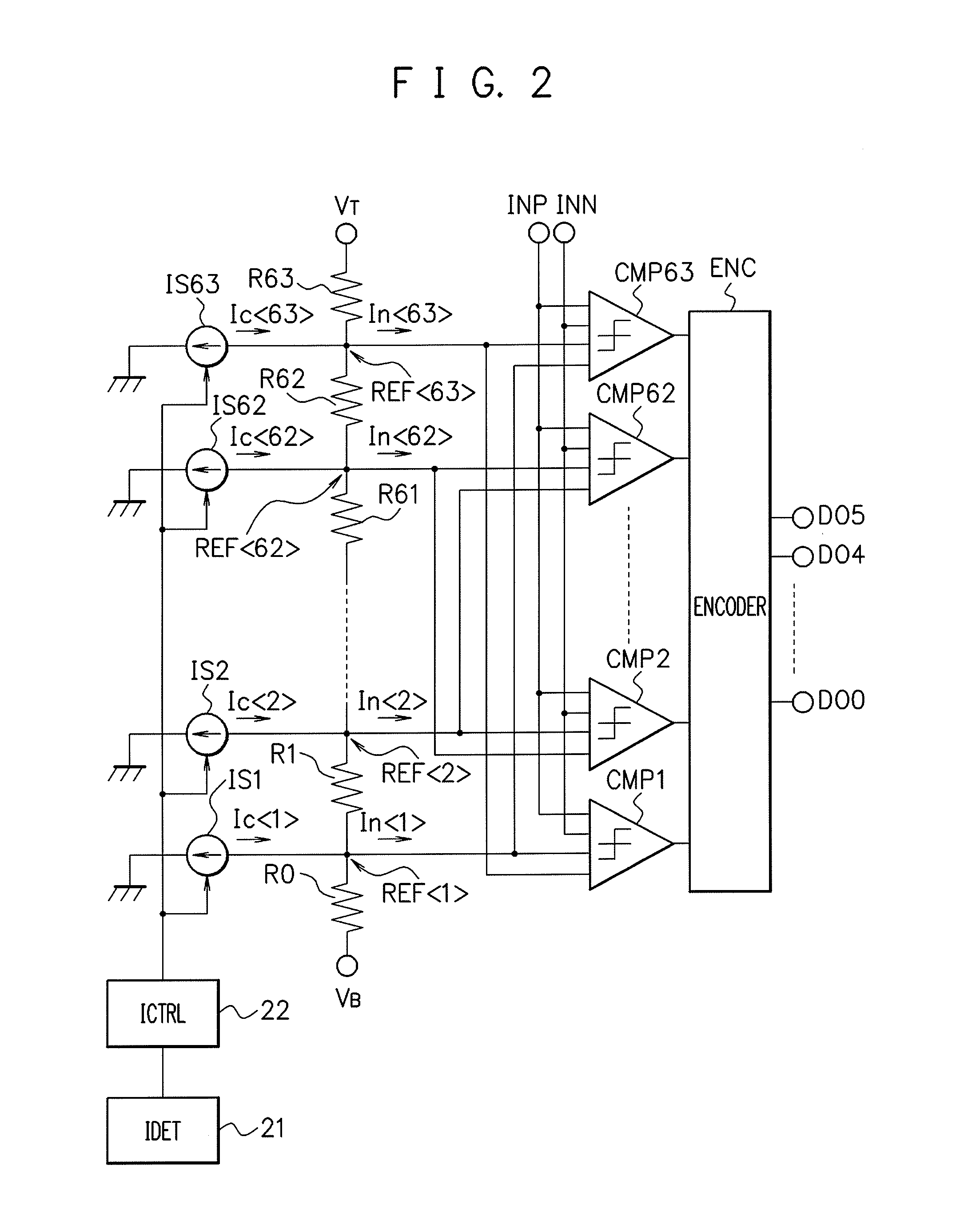Analog-digital converter
a digital converter and analog technology, applied in the field of analog digital converters, can solve the problems of large percentage of power consumption of parallel-type ad converters, power consumption increase, and accuracy deterioration of resistor ladder circuits, so as to suppress the effect of noise current, suppress the effect of bias current, and reduce the bias current
- Summary
- Abstract
- Description
- Claims
- Application Information
AI Technical Summary
Benefits of technology
Problems solved by technology
Method used
Image
Examples
first embodiment
[0038]There will be explained a first embodiment of the present invention.
[0039]An AD converter in the first embodiment supplies a current that is the same in magnitude as the noise current In generated by the comparator and flows in a reverse direction to the connection point REF in the resistor ladder circuit corresponding to the output node of the comparison reference potential VREF, to thereby offset the noise current In and suppress the potential variation in the resistor ladder circuit. FIG. 1 is a diagram illustrating a configuration example of an AD converter in the first embodiment. FIG. 1 illustrates a parallel-type AD converter that converts input analog input signals to n-bit (n being a natural number) digital signals DO[n−1:0] (a flash AD converter) as one example. In FIG. 1, R0 to Rm (m=2n−1) represent resistors, and IS1 to ISm represent current sources. Further, CMP1 to CMPm represent comparators (comparators), and ENC represents an encoder.
[0040]The resistors R0 to R...
second embodiment
[0045]Next, there will be explained a second embodiment of the present invention.
[0046]A potential variation ΔV at the connection point REF in the resistor ladder circuit caused by the noise current In that the comparator generates is expressed by (Expression 3).
[0047][Mathematical expression 3]
ΔV<i>=R·Ceff·i(N-i){ΔVq(N+i)-3(Vcom-VB)}3tcCeff=Cp·CsCp+CsΔVq=VT-VBNVcom=VINP+VINN2(Expression3)
[0048]In aforementioned (Expression 3), R represents a resistance value of the resistor configuring the resistor ladder circuit, Cs represents a capacitance value of the sampling capacitor provided in the comparator, and Cp represents a capacitance value of the parasitic capacitor in the comparator. Further, N represents the number of resistors configuring the resistor ladder circuit (the number of potential ranges divided by the comparison reference potentials that the resistor ladder circuit generates), VT represents a reference voltage on the high potential side, VB represents a reference ...
third embodiment
[0057]Next, there will be explained a third embodiment of the present invention.
[0058]In the first and second embodiments, for each of the connection points REF1> to REF in the resistor ladder circuit, the current source ISi provided for supplying the correction current Ic is provided, but as described previously, the current source ISi is provided only for the connection point REF where the variation in the potential VREF caused by the noise current In is expected to be large, and thereby it is possible to improve the potential variation in the resistor ladder circuit caused by the noise currents In.
[0059]In the third embodiment to be explained below, the current source ISi is provided for the connection point REF where the variation in the potential VREF in the resistor ladder circuit caused by the noise current In is expected to be large. FIG. 9 is a diagram illustrating a configuration example of an AD converter in the third embodiment. In FIG. 9, for connection points REF posit...
PUM
 Login to View More
Login to View More Abstract
Description
Claims
Application Information
 Login to View More
Login to View More - R&D
- Intellectual Property
- Life Sciences
- Materials
- Tech Scout
- Unparalleled Data Quality
- Higher Quality Content
- 60% Fewer Hallucinations
Browse by: Latest US Patents, China's latest patents, Technical Efficacy Thesaurus, Application Domain, Technology Topic, Popular Technical Reports.
© 2025 PatSnap. All rights reserved.Legal|Privacy policy|Modern Slavery Act Transparency Statement|Sitemap|About US| Contact US: help@patsnap.com



